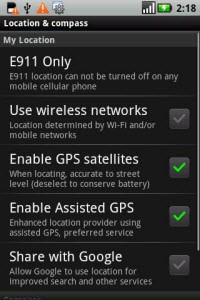Why mobile devices are fundamentally different
Cell phones, smart phones, and new mobile devices will open up new marketing and measurement opportunities that have never been possible before. Traditional marketing is focused on the four P’s: Product, Price, Place, and Promotion, and the essentials of marketing are still true in a mobile world, but now there is a fifth “P” to consider. This is “Profile”, which refers to the “digital profile” of the customer.

A digital profile is everything we know about the individual based on our information systems. Relational database technology (RDMS) and eCommerce originally developed this capability, to the point that we can now dynamically pull together a rich set of facts about a potential customer in milliseconds. Visit Amazon.com and be amazed at how you and your purchases are remembered, and how the interaction of Amazon with each of its customers is tailored based on this information. In fact our ability to relate, search, and match information against vast amounts of data improves every year – which means that the “digital profile” will also continue to improve.
Let’s look at how mobile technology impacts each of the 5 Ps…
Profile (Digital Profile)
Mobile devices enrich the digital profile by providing a very precise location of the customer. Simply providing the longitude and latitude will tell marketers where there customer is within a meter using GPS technology. iPads, iPhones, Android phones and even Mac notebooks have this GPS functionality build in.
This means that in addition to all the eCommerce information we have about a customer, we also know WHERE the customer is and, WHEN the customer is there. From this we can derive the MOTION of the customer if riding a train, driving, or walking, for example. (Even shaking the device will provide gyroscopic information, so joggers can be differentiated from cyclists for example).
Some people fear the implications of this much information being available, but ultimately privacy fears are offset by the fact that mobile devices and browsers will give the individual the power to control what information is given. In the same way that current browsers allow the user to enable or disable cookies and Javascript, mobile device users will be able to control what information is shared with Websites and online service providers. For example, the Nexus One android phone allows for GPS functionality and information sharing with Google to be controlled by the user of the device. Simply un-check the box and GPS information about you and your phone will go dark.

In the standard Android 2.2.1 browser on the Nexus One, in the settings just below “Enable Javascript” and “Allow Cookies” there is a check box to “Enable Location”, which says “Allow sites to request access to your location”. So, even at the browser level you could choose not to share your location. Note that by default this information is shared, so most mobile device users will share this information. The iPhone does not have this browser option yet, but it does have GPS settings control under: Settings -> General -> Location Services. Here you can control the information provided for each application.
Place
Mobile phones will have a long term impact on where businesses locate. In the same way that a gas station locates next to a highway where there are many cars that need fuel, businesses of the future may make decisions on where to locate based on the new business intelligence associated with “mobile analytics”. For example, Starbucks may see the number of visitors to its Websites from mobile devices concentrated within in a few city blocks. This may provide the business case for opening a new Starbucks location in the area.
Promotion
Mobile devices will have an enormous impact on “promotion”. This is why Google has moved into the mobile phone game – Google Adwords is the largest online adverting platform in the world and it continues to grow at an impressive rate. Future growth will come by increasing the number of opportunities to place “relevant” Ads in front of people. Mobile phones provide this opportunity – and there was simply too much at stake to allow Apple to win and control this opportunity. iAd is Apple’s new ad serving platform, and being first-to-market with the iPhone has provided Apple with an opportunity to grow the long term revenue stream associated with Adertising – specifically the high growth mobile advertising segment. Increasingly Apple, like Facebook has exhibited a proprietary and closed business model – which is a risk to Google.
Let’s imagine one type of promotional opportunity on the horizon for mobile advertisers…
- A person uses her mobile device to search for “coffee shop”. Then a paid ad displays showing the location of the nearest coffee shop (relevance), the distance to the coffee shop, and how long it will take to get there + any specials being offered in the next 15 minutes…
- This person clicks through on the ad to claim the coupon and provide a phone number or email address to identify themselves and claim the discount or promotion.
- The Web Analytics system “remembers” who the person is, where they were standing (GPS), and the time of day.
- Specials are delivered to the person’s mobile device at the same time and day the next week to encourage repeat business… (we are creatures of habit, so the same time, next week may be the perfect time remind us of the coffee shop, for example).
- Broadly we are using time of day and location to establish “relevance”.
Product
Mobile devices do not change the products and services of “bricks and mortar” businesses, with the exception of mobile phone accessories, and the phones and service contracts themselves.
Price
Mobile devices do not change the price of products. Pizzas and oil changes will still cost what they cost…
Mobile Analytics (Mobile-lytics)
Currently Google Analytics and data providers like Maxmind are limited in the Geographical precision of the information. As the mobile internet grows and more devices use GPS, the quality of this information will skyrocket and there will be a dramatic increase in the precision in location based information. The following images show current Google Analytics information is currently only down to the city level – with an estimated 80% accuracy on average.


The above image shows the current limit of Web Analytics information. In the future Google Analytics information will likely be “augmented” and integrated with information from Google Maps, Google Places, Google Street View and Google Earth etc…

Mobile Facts in Canada
Nielsen reports that mobile penetration is increasing at an impressive rate. With the following notable factoids:
- Mobile Internet adoption in Canada is reaching critical mass, with 21 % of mobile consumers using their mobile phones to browse the Web and access their e-mail accounts.
- Mobile internet penetration increased from 16 percent in Q4 2008 to 21.3 percent in Q1 2009
- There are 3.9M unique mobile internet users in Canada
- Nearly three-quarters (74.3%) of Canadian households indicated they had a cell phone in 2008, up from (72.4%) in 2007.
- The proportion of households with cell phones was highest in Alberta (84.5%), Saskatchewan (78.0%), British Columbia (77.8%) and Ontario (76.8%). Quebec had the lowest rate of cell phone use at 65.5% of households.
- Younger households were much more likely to use only a cell phone, with 34.4% of households comprised solely of adults aged between 18 and 34 relying exclusively on cell phones. Among all other households the rate was 4.5%.
- Younger households were much more likely to use only a cell phone, with 34.4% of households comprised solely of adults aged between 18 and 34 relying exclusively on cell phones. Among all other households the rate was 4.5%.
- Mobile advertising revenues in Canada skyrocketed 347% to $11.9-million in 2008, surpassing budgeted expectations of $5.2-million for the year. Source
- For 2009, mobile advertising revenue in Canada was forecast to grow by 50% over 2008 totals, to an estimated $18-million. Source
Manager, Google Analytics Services
PublicInsite Web Analytics Inc.Contact us to learn more about what PublicInsite can do for you.
















